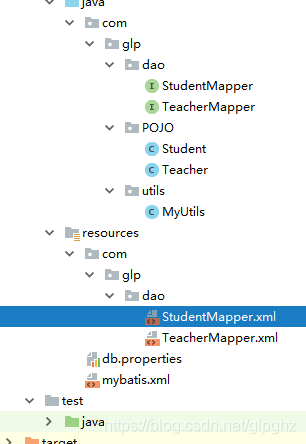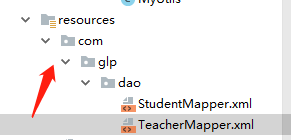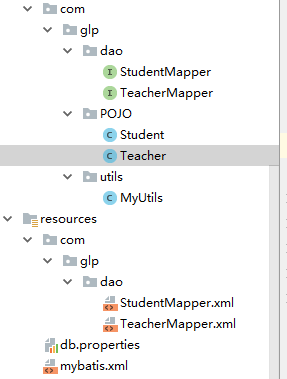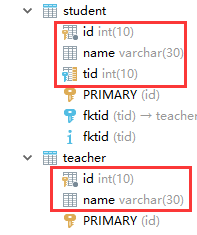您好,登錄后才能下訂單哦!
您好,登錄后才能下訂單哦!
這篇文章主要為大家展示了“Mybatis中如何使用復雜對象resultMap”,內容簡而易懂,條理清晰,希望能夠幫助大家解決疑惑,下面讓小編帶領大家一起研究并學習一下“Mybatis中如何使用復雜對象resultMap”這篇文章吧。
數據對象含有普通屬性,一對一對象,一對多對象(2種情況:單一主鍵和復合主鍵)
<resultMap id="GoodsResultMap" type="GoodsModelCustomize"> <id property="goods_cd" column="goods_cd" /> <result property="production_company_cd" column="production_company_cd" /> <result property="production_place_cd" column="production_place_cd" /> <result property="goods_nm_jp" column="goods_nm_jp" /> <result property="goods_nm_en" column="goods_nm_en" /> <result property="goods_nm_zh" column="goods_nm_zh" /> <result property="goods_type" column="goods_type" /> <result property="goods_package" column="goods_package" /> <result property="upd_dttm" column="upd_dttm" /> <association property="productioncompany" column="production_company_cd" javaType="trade.db.model.Productioncompany"> <id property="production_company_cd" column="production_company_cd"/> <result property="company_nm_jp" column="company_nm_jp"/> <result property="company_rnm_jp" column="company_rnm_jp"/> </association> <collection property="goodsnutrientList" column="goods_cd" ofType="trade.db.model.Goodsnutrient" select="getGoodsnutrient" /> <collection property="liquorgoodsccicList" column="goods_cd" ofType="trade.db.model.Liquorgoodsccic" select="getLiquorgoodsccic"> <id property="goods_cd" column="goods_cd" /> <id property="ccic_item_cd" column="ccic_item_cd"/> <result property="ccic_item_val1" column="ccic_item_val1"/> </collection> <collection property="projectgoodsList" column="goods_cd" ofType="trade.db.model.Projectgoods" select="getProjectgoods"> <id property="project_goods_cd" column="project_goods_cd"/> <result property="project_cd" column="project_cd"/> <result property="goods_cd" column="goods_cd"/> </collection> </resultMap> <resultMap id="GoodsnutrientResultMap" type="Goodsnutrient"> <id property="goods_cd" column="goods_cd" /> <id property="nutrient_item_cd" column="nutrient_item_cd" /> <result property="sort_no" column="sort_no" /> <result property="nutrient_value" column="nutrient_value" /> <result property="nutrient_nrv" column="nutrient_nrv" /> <result property="upd_dttm" column="upd_dttm" /> </resultMap>
一對一屬性productioncompany
一對多屬性goodsnutrientList(復合主鍵,返回的復雜對象內有數據)
一對多屬性liquorgoodsccicList(復合主鍵,返回的復雜對象內沒有數據)
一對多屬性projectgoodsList(單一主鍵,返回的復雜對象內有數據)
<select id="getGoodsnutrient" parameterType="String" resultMap="GoodsnutrientResultMap">
SELECT
m_goods_nutrient.*
FROM m_goods_nutrient
<where>
m_goods_nutrient.goods_cd = #{goods_cd}
AND m_goods_nutrient.del_flg = '0'
</where>
</select>
<select id="getLiquorgoodsccic" parameterType="String" resultType="trade.db.model.Liquorgoodsccic">
SELECT
m_liquorgoods_ccic.*
FROM m_liquorgoods_ccic
<where>
m_liquorgoods_ccic.goods_cd = #{goods_cd}
AND m_liquorgoods_ccic.del_flg = '0'
</where>
</select>
<select id="getProjectgoods" parameterType="String" resultType="trade.db.model.Projectgoods">
SELECT
t_project_goods.*
FROM t_project_goods
<where>
t_project_goods.goods_cd = #{goods_cd}
AND t_project_goods.del_flg = '0'
</where>
</select>
<select id="findByPrimaryKey" parameterType="String" resultMap="GoodsResultMap">
SELECT
m_goods.*,
m_production_company.*,
now() AS SELECT_TIME
FROM m_goods
LEFT JOIN
m_production_company
ON m_goods.production_company_cd = m_production_company.production_company_cd
AND m_production_company.del_flg = '0'
WHERE
m_goods.goods_cd = #{primary_key}
AND m_goods.del_flg = '0'
</select>通過findByPrimaryKey方法獲取普通屬性和1對1對象屬性
通過getGoodsnutrient方法獲取1對多復合主鍵的屬性,注意返回類型的配置為resultMap=“GoodsnutrientResultMap”(返回的對象的List屬性內有數據)
通過getLiquorgoodsccic方法獲取1對多復合主鍵的屬性,此處的返回類型為 resultType=“trade.db.model.Liquorgoodsccic”(返回的對象的List屬性內沒有數據)
通過getProjectgoods方法獲取1對多單一主鍵的屬性,此處的返回類型為resultType=“trade.db.model.Projectgoods”(返回的對象的List屬性內有數據)
public class GoodsModelCustomize extends Goods {
/**
* 製造會社
*/
private Productioncompany productioncompany;
public Productioncompany getProductioncompany() {
return productioncompany;
}
public void setProductioncompany(Productioncompany productioncompany) {
this.productioncompany = productioncompany;
}
/**
* 商品栄養成分
*/
private List<Goodsnutrient> goodsnutrientList;
public List<Goodsnutrient> getGoodsnutrientList() {
return goodsnutrientList;
}
public void setGoodsnutrientList(List<Goodsnutrient> goodsnutrientList) {
this.goodsnutrientList = goodsnutrientList;
}
/**
* 酒類商品CCIC
*/
private List<Liquorgoodsccic> liquorgoodsccicList;
public List<Liquorgoodsccic> getLiquorgoodsccicList() {
return liquorgoodsccicList;
}
public void setLiquorgoodsccicList(List<Liquorgoodsccic> liquorgoodsccicList) {
this.liquorgoodsccicList = liquorgoodsccicList;
}
/**
* 項目商品列表
*/
private List<Projectgoods> projectgoodsList;
public List<Projectgoods> getProjectgoodsList() {
return projectgoodsList;
}
public void setProjectgoodsList(List<Projectgoods> projectgoodsList) {
this.projectgoodsList = projectgoodsList;
}
}普通屬性繼承與Goods代碼省略,上述屬性productioncompany,goodsnutrientList和projectgoodsList有數據,但是liquorgoodsccicList沒有數據
因此,當返回對象內有1對多的List屬性,同時此list為復合主鍵的話,推薦使用resultMap來對返回數據映射。

association:關聯(多對一的情況)
collection: 集合(一對多的情況)
javaType: 用來指定實體類中屬性的類型。
ofType: 用來指定映射到List或集合中POJO的類型,泛型的約束類型。
數據庫表:
CREATE TABLE `teacher` (
`id` INT(10) NOT NULL,
`name` VARCHAR(30) DEFAULT NULL,
PRIMARY KEY (`id`)
) ENGINE=INNODB DEFAULT CHARSET=utf8;
INSERT INTO teacher(`id`, `name`) VALUES (1, '王老師');
CREATE TABLE `student` (
`id` INT(10) NOT NULL,
`name` VARCHAR(30) DEFAULT NULL,
`tid` INT(10) DEFAULT NULL,
PRIMARY KEY (`id`),
KEY `fktid` (`tid`),
CONSTRAINT `fktid` FOREIGN KEY (`tid`) REFERENCES `teacher` (`id`)
) ENGINE=INNODB DEFAULT CHARSET=utf8;
INSERT INTO `student` (`id`, `name`, `tid`) VALUES ('1', '小明', '1');
INSERT INTO `student` (`id`, `name`, `tid`) VALUES ('2', '小紅', '1');
INSERT INTO `student` (`id`, `name`, `tid`) VALUES ('3', '小張', '1');
INSERT INTO `student` (`id`, `name`, `tid`) VALUES ('4', '小李', '1');
INSERT INTO `student` (`id`, `name`, `tid`) VALUES ('5', '小王', '1');
@Data
public class Student {
private int id;
private String name;
private Teacher teacher;
}@Data
public class Teacher {
private int id;
private String name;
}public interface StudentMapper {
//查詢所有學生的信息
List<Student> getStudent();
List<Student> getStudent2();
}為了達到和接口在同一個包中的效果,在resource文件夾下新建包結構com.glp.dao:

<?xml version="1.0" encoding="UTF-8" ?>
<!DOCTYPE mapper
PUBLIC "-//mybatis.org//DTD Config 3.0//EN"
"http://mybatis.org/dtd/mybatis-3-mapper.dtd">
<mapper namespace="com.glp.dao.StudentMapper">
<!--按照結果查詢——聯表查詢-->
<select id="getStudent2" resultMap="StudentMap2">
select s.id sid,s.name sname,t.name tname from student s, teacher t where s.tid=t.id;
</select>
<resultMap id="StudentMap2" type="Student">
<result property="id" column="sid"/>
<result property="name" column="sname"/>
<association property="teacher" javaType="Teacher">
<result property="name" column="tname"/>
</association>
</resultMap>
<!--按照查詢嵌套處理——子查詢-->
<select id="getStudent" resultMap="StudentMap" >
select * from student;
</select>
<resultMap id="StudentMap" type="Student">
<result property="id" column="id"/>
<result property="name" column="name"/>
<!--復雜屬性:對象association, 集合collection-->
<association property="teacher" column="tid" javaType="Teacher" select="getTeacher"/>
</resultMap>
<select id="getTeacher" resultType="Teacher">
select * from teacher where id = #{id};
</select>
</mapper>在多對一查詢中,需要用到teacher這個表,每個學生都對應著一個老師。而property只能處理單個屬性,像teacher這種復雜屬性(內含多個屬性)需要進行處理。處理復雜對象要用association 。
方式一:聯表查詢(直接查出所有信息,再對結果進行處理)
<resultMap id="StudentMap2" type="Student"> <result property="id" column="sid"/> <result property="name" column="sname"/> <association property="teacher" javaType="Teacher"> <result property="name" column="tname"/> </association> </resultMap>
直接查詢出學生和老師,然后用association去取老師里面的屬性property。
方式二:子查詢(先查出學生信息,再拿著學生中的tid,去查詢老師的信息)
<resultMap id="StudentMap" type="Student">
<result property="id" column="id"/>
<result property="name" column="name"/>
<!--復雜屬性:對象association-->
<association property="teacher" column="tid" javaType="Teacher" select="getTeacher"/>
</resultMap>
<select id="getTeacher" resultType="Teacher">
select * from teacher where id = #{id};
</select>在resultMap中引入屬性association,通過javaType指定property="teacher"的類型,javaType="Teacher"。通過select引入子查詢(嵌套查詢)。

這里是拿到學生中的tid,去查找對應的老師。
db.properties:數據庫連接參數配置文件
driver = com.mysql.jdbc.Driver url=jdbc:mysql://localhost:3306/mybatis?useSSL=true&useUnicode=true&chracterEncoding=utf8 username =root password =mysql
mybatis.xml:
<?xml version="1.0" encoding="UTF-8" ?>
<!DOCTYPE configuration
PUBLIC "-//mybatis.org//DTD Config 3.0//EN"
"http://mybatis.org/dtd/mybatis-3-config.dtd">
<configuration>
<properties resource="db.properties">
<property name="username" value="root"/>
<property name="password" value="mysql"/>
</properties>
<settings>
<setting name="logImpl" value="STDOUT_LOGGING"/>
</settings>
<typeAliases>
<typeAlias type="com.glp.POJO.Student" alias="Student"/>
<typeAlias type="com.glp.POJO.Teacher" alias="Teacher"/>
</typeAliases>
<environments default="development">
<environment id="development">
<transactionManager type="JDBC"/>
<dataSource type="POOLED">
<property name="driver" value="${driver}"/>
<property name="url" value="${url}}"/>
<property name="username" value="${username}"/>
<property name="password" value="${password}"/>
</dataSource>
</environment>
</environments>
<mappers>
<mapper class="com.glp.dao.StudentMapper"/>
<mapper class="com.glp.dao.TeacherMapper"/>
</mappers>
</configuration>注意:
要保證接口和Mapper.xml都在同一個包中。
(5) 測試
public class UserDaoTest {
@Test
public void getStudent(){
SqlSession sqlSession = MyUtils.getSqlSession();
StudentMapper mapper = sqlSession.getMapper(StudentMapper.class);
List<Student> list = mapper.getStudent();
for (Student stu:list ) {
System.out.println(stu);
}
sqlSession.close();
}
@Test
public void getStudent2(){
SqlSession sqlSession = MyUtils.getSqlSession();
StudentMapper mapper = sqlSession.getMapper(StudentMapper.class);
List<Student> list = mapper.getStudent2();
for (Student stu:list ) {
System.out.println(stu);
}
sqlSession.close();
}
}
@Data
public class Student {
private int id;
private String name;
private int tid;
}@Data
public class Teacher {
private int id;
private String name;
private List<Student> students;
}package com.glp.dao;
public interface TeacherMapper {
Teacher getTeacher(@Param("tid") int id);
Teacher getTeacher2(@Param("tid") int id);
}<?xml version="1.0" encoding="UTF-8" ?>
<!DOCTYPE mapper
PUBLIC "-//mybatis.org//DTD Config 3.0//EN"
"http://mybatis.org/dtd/mybatis-3-mapper.dtd">
<mapper namespace="com.glp.dao.TeacherMapper">
<!--方式一 ======================= -->
<select id="getTeacher" resultMap="TeacherStudent">
select s.id sid, s.name sname, t.name tname, t.id tid from
student s ,teacher t where s.tid = t.id and t.id = #{tid};
</select>
<resultMap id="TeacherStudent" type="Teacher">
<result property="id" column="tid"/>
<result property="name" column="tname"/>
<collection property="students" ofType="Student">
<result property="id" column="sid"/>
<result property="name" column="sname"/>
<result property="tid" column="tid"/>
</collection>
</resultMap>
<!--方式二 ======================= -->
<select id="getTeacher2" resultMap="TeacherStudent2">
select * from teacher where id = #{tid};
<!--這里的tid和接口中指定的屬性名相同-->
</select>
<resultMap id="TeacherStudent2" type="Teacher">
<result property="id" column="id"/>
<result property="name" column="name"/>
<!--上面的兩個可以省略-->
<collection property="students" column="id" javaType="ArrayList" ofType="Student" select="getStuById"/>
</resultMap>
<select id="getStuById" resultType="Student">
select * from student where tid=#{tid};
<!--查詢老師對應的學生,#{tid}-->
</select>
</mapper>方式一:聯表查詢,需要寫復雜SQL
collection 用來處理集合,ofType用來指定集合中的約束類型
聯合查詢時,查詢出所以結果,然后再解析結果中的屬性,將屬性property賦予到collection中。
方式二:子查詢,需要寫復雜映射關系


查詢學生時,需要拿著老師的id去查找,column用來給出老師的id。
package com.glp.dao;
public class UserDaoTest {
@Test
public void getTeacher(){
SqlSession sqlSession = MyUtils.getSqlSession();
TeacherMapper mapper = sqlSession.getMapper(TeacherMapper.class);
Teacher teacher = mapper.getTeacher(1);
System.out.println(teacher);
sqlSession.close();
}
@Test
public void getTeacher2(){
SqlSession sqlSession = MyUtils.getSqlSession();
TeacherMapper mapper = sqlSession.getMapper(TeacherMapper.class);
Teacher teacher = mapper.getTeacher2(1);
System.out.println(teacher);
sqlSession.close();
}
}以上是“Mybatis中如何使用復雜對象resultMap”這篇文章的所有內容,感謝各位的閱讀!相信大家都有了一定的了解,希望分享的內容對大家有所幫助,如果還想學習更多知識,歡迎關注億速云行業資訊頻道!
免責聲明:本站發布的內容(圖片、視頻和文字)以原創、轉載和分享為主,文章觀點不代表本網站立場,如果涉及侵權請聯系站長郵箱:is@yisu.com進行舉報,并提供相關證據,一經查實,將立刻刪除涉嫌侵權內容。